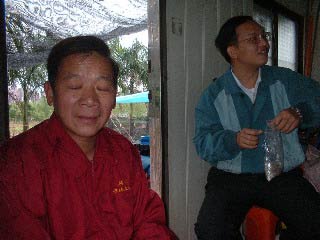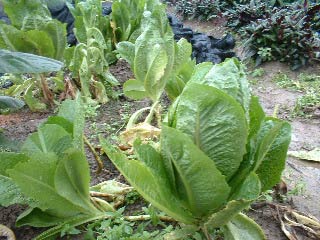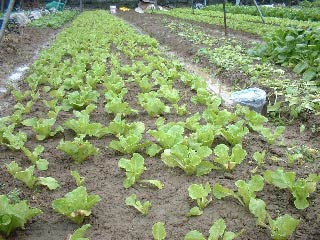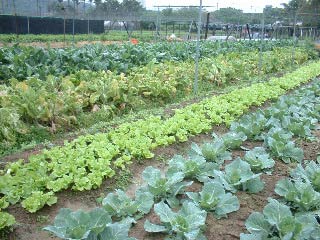Taiwan Urban Agriculture (Page 3)
By Robin Turner
arobint@interchange.ubc.ca
[Robin is a University of British Columbia student who is travelling in Taiwan for a few months. He will send us his research material from time to time. (Ed.)]
April 6, 2003
One of the phenomena I have encountered here is that although there is a lot of things you may call urban agriculture, the fact is that all agriculture is on such a small scale that it could be called urban agriculture when compared to agriculture in Canada. As well, urbanization is so dense that there are few places which could be called rural.
As for now, I have become very interested in Taiwan's agricultural history, particularly the land reform which occurred after mainland Chinese forces took over the island in 1949.
It turns out that Taiwan's land reform was one of the most successful economic turn-arounds in history, turning the island into a net food exporter within ten years of implementation. It also gave the nations poor a steady and reliable income which provided the basis for further industrialization and development.
Basically land was divided up and given out to the people who were originally tilling it. Rents were reduced to 37.5%, government loans were provided to purchase land, and plot size was reduced to a maximum of 4 hectares per person. Also, taxes were not applied to extra crops planted in a year, and this encouraged a boom in productivity and farmers income.
The land reform was implemented with careful planning and management, and required government support in the form of active participation as well as protectionism. A complete ban on the trade of many crops including rice was introduced, and all agriculture imports had very stiff tariffs. Although this lead to Taiwan having higher commodity prices than the world average, it allowed for absolute food security as well as high incomes for the island's poor.
Not surprisingly, as Taiwan moves in to the modernity, she has focussed all her attentions on trade and industry, while agriculture, the one time national breadwinner, takes a back seat with only a 3% share of GDP. Now with having attained entrance into the WTO, protection of the agricultural sector is at all time lows. It has caused the prices of produce to plummet with tariff reduction, with subsequent losses to farmer income. Farmers have been protesting vehemently, with 120,000 congregating on Taipei in December, to no avail.
Seeking to find some personal insight into this new obstacle for farming in Taiwan, I contacted the local farmer's association in Hsintien. I spent some time tracking down a person who could help me in this weighty organization, which acts as a credit agency, training center, advisory board, marketing board, and political liaison for Taiwan's farmers. I eventually found Mr Ye, who works with farmers in developing crop strategies and growing methods most appropriate for their needs. He took me out to meet a farmer who had been working the land on the fringe of Hsintien for 50 years.

Mr Lau and I drank tea in a neighbor farmer's tool shed, while Mr Ye from the Farmer's talks to the neighbor in the background. I wanted to get a feel for what farming was like in Taiwan in the good old days as compared to now, and I found the right person. Mr Lau had been working the land in Hsintien since he was a boy with his father. He remembered what it was like originally. At first they could only grow three crops: sweet potatoes, turnips and cabbage. With little money for fertilizer, or any kind of crop protection, these hardy crops were the only ones that guaranteed food on the table or for the marketplace. The only form of pest control they had was picking bugs from the vegetables by hand! Mr Lau and his father rented the land from a local landlord (about 2 hectares, all told) and paid the landlord with two thirds of their crop. Hardly a good way to make a living! This also discouraged farmers from increasing productivity or diversifying, as very little of profits would see the farmers pockets anyway. Mr Lau then recounted what happened with land reform, as the landlords were forced to sell land to the government, and rents dropped to 37.5 percent of the crop. At the same time, much effort was expended in promoting crop diversification, rotation, and methods for pest control. As well, pesticides and fertilizers were provided at reasonable cost. Production exploded, and they quickly went from three hardy crops to what they have now, over thirteen varieties of vegetables, mostly of the more vulnerable (and profitable) leafy variety.

As we toured Mr Lau's pipe farm, which covers a tenth of a hectare (10m x 100m), he told me that in the 60's and seventies, being a farmer was a very profitable venture in Taiwan. As people prospered with the income from farming, and then commerce, the demand for more and better food grew along with the population. A ban on imports meant that farmers could have a very comfortable standard of living, and kept a reasonable portion farmers farming. He told me that he could show up at market with a load of produce and be sold out by noon, with the rest of the day to tend to his business. The money from this allowed him to build one of the pipe enclosures that is so common in Taiwan. Fitted with plastic which protects against the torrential rains and the blistering heat in the summer, it is also lined with irrigation pipes.

The crop here is a Taiwanese celery, which he allows a fair amount of pest action. The leaves on these plants were fairly hole ridden. He assured me that this was normal, and that buyers used the stalk and not the leaves anyway. He applies pesticides by using the irrigation pipes which spray from overhead. He was clearly very conservative in their use.
The ground in the background is lying fallow, as it does every year for about a month. Crop rotation is the normal way of things, as planting the same crops just encourages pests and disease.
Crop identification is always difficult for me here, as they all have chinese names, which dont necessarily translate to English.

A big healthy head of Da Bai Cai.

A crop from Mainland China called Dalu Mei

Much more variety than the good old days. As we wrapped up our little tour, we took some more tea in the tool shed, and Mr Lau told me that now things were getting much more difficult for farmers in Taiwan. Much of the hardship comes in the form of lower prices that accompany WTO price cuts. However, he also blamed the loss of factories and capital to Mainland China as the sister countries open up relations again. While food prices are going down in Taiwan, money is also leaving at astounding rates, along with the factories and jobs that accompany it. "Just when Taiwan needs people to spend more money to support her own farmers, all this financial hardship is making it difficult for people to now just buy the cheapest stuff on the shelf. As a result, Taiwanese farmers suffer."
So thats Mr Lau's story. I will send another update about his neighbor, who grows herbs and flowers for market, as an indicator of the direction that farmers are taking to try to survive in the low price environment of post WTO Taiwan.

![[new]](new01.gif)
